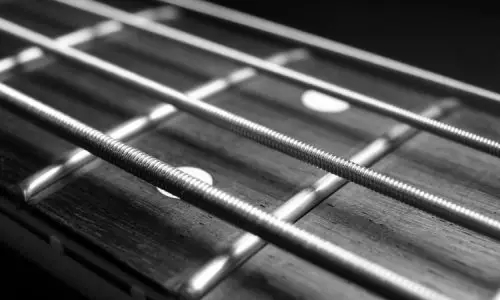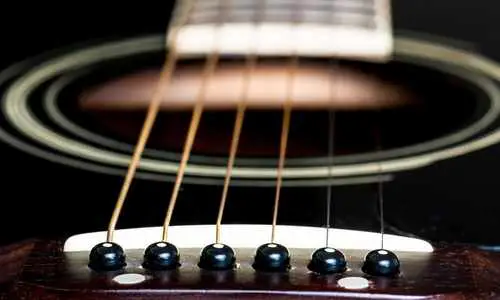The best string gauge for an electric guitar depends on several factors. These include playing style, genre of music, and personal preference. However, there are some common string gauges that are often recommended for different playing styles.
For beginners and those who prefer a lighter touch, a lighter string gauge such as .009 – .042 or .010 – .046 is often a good choice. These strings are easier to fret and bend, making them ideal for players who are still developing their finger strength and technique. They also tend to produce a brighter tone and are popular among players in genres such as pop, rock, and country.
On the other hand, players who prefer a heavier sound and want to achieve more sustain and a thicker tone may opt for a heavier string gauge. Common choices for heavier gauges include .011 – .049 or .012 – .052. These strings require more finger strength to play, but they can provide a rich and full-bodied sound, making them well-suited for genres such as blues, hard rock, and metal.
It’s important to note that string gauge is not the only factor that affects tone. The type of pickups on your guitar, the type of wood used in the construction of the instrument, and your amp settings all play a role in shaping your tone. Experimenting with different string gauges can help you find the right balance for your playing style and guitar setup.
When changing string gauge, it’s also important to consider any necessary adjustments to your guitar’s setup. Heavier strings can put more tension on the neck, requiring adjustments to the truss rod and bridge. It’s best to consult a professional guitar technician if you are unsure about making these adjustments yourself.
Ultimately, the best string gauge for your electric guitar is a matter of personal preference. It’s worth trying out different gauges to find the one that feels and sounds the best to you. Remember, what works for one guitarist may not work for another, so don’t be afraid to experiment and find your own preferred string gauge.
Here’s a summary that sums up the entire article if you are too busy. Otherwise, read till the end because there are much more to the topic!
| String Gauge | Advantages | Disadvantages |
|---|---|---|
| .009 – .042 or .010 – .046 | – Easier to fret and bend – Produces a brighter tone – Popular for pop, rock, and country genres |
– May lack low-end punch – Can be easier to break |
| .011 – .049 or .012 – .052 | – Provides a fuller and heavier tone – Handles high levels of distortion well – Popular for blues, hard rock, and metal genres |
– Requires more finger strength – May require adjustments to guitar setup |
| Lighter Gauge Strings | – Easier to play – Facilitates fast and intricate techniques – Produces a brighter tone – Can be more forgiving on fingers |
– May lack low-end punch and sustain – Higher risk of breakage |
| Heavier Gauge Strings | – Provides a fuller and heavier tone – Offers more sustain – Can handle high levels of distortion |
– Requires more finger strength – Puts more strain on the guitar’s neck – Potentially limits certain playing techniques |
| Intonation | – Thicker strings have higher tension, requiring longer scale length – Thinner strings may need shorter scale length – Proper intonation setup is crucial when changing string gauge |
– Changes in string gauge may require other adjustments to guitar setup – Professional assistance may be necessary |
| Overall | – String gauge choice is subjective and depends on individual preferences – Consider playability, tone, and personal playing style |
– String gauge affects intonation and may require adjustments – What works for one player may not work for another |
What is the most popular string gauge for electric guitar?

Most popular string gauge for electric guitars is .010 – .046
The most common and widely used gauge for electric guitars is .010 – .046. However, this depends widely on the genre and individual preferences of the players.
This gauge, often referred to as “regular” or “light,” strikes a balance between playability and tone. It offers a comfortable feel while still providing enough tension for good intonation and control over the strings. Many players find that this gauge allows for easy bending and vibrato techniques, making it suitable for a wide range of musical styles, including rock, blues, and jazz.
Additionally, the .010 – .046 gauge is versatile and works well with various types of pickups and guitar setups. It produces a balanced tone with a good amount of brightness and articulation, making it an excellent choice for rhythm and lead playing. Many electric guitar string manufacturers offer this gauge as their standard set, further contributing to its popularity.
That being said, it’s important to consider that individual preferences and playing styles can greatly influence the choice of string gauge. Some players might prefer a slightly lighter gauge, such as .009 – .042, for its ease of playability and ability to facilitate fast and intricate playing. On the other hand, players who desire a thicker and heavier tone may opt for a gauge like .011 – .049.
Ultimately, the choice of electric guitar gauge depends on your personal playing style, genre of music, and the specific tone you are striving to achieve. It can be helpful to experiment with different gauges to find the one that feels and sounds best for your individual needs. Consider factors such as string tension, flexibility, and the overall feel under your fingers when selecting the perfect electric guitar gauge for you.
Remember, what works for one guitarist may not work for another, so don’t be afraid to try different gauges and find your own preferred setup. Whether you stick with the popular .010 – .046 gauge or explore other options, the most important thing is to find a string gauge that enhances your playing experience and allows you to express yourself fully on the electric guitar.
Also Read: Beginner’s Guide: The Easiest String Gauge for Your Guitar
Thicker vs thinner gauge strings for electric guitar

Lighter gauge is easier to player but heavier gauge has more tone.
Thicker gauge strings, such as .011 – .049 or .012 – .052, offer several advantages. They provide more tension and resistance under the fingers, which can be beneficial for players who prefer a harder attack or want to achieve a fuller and heavier tone. Thicker strings also tend to sustain longer and can handle higher levels of distortion without becoming too muddy or losing clarity.
On the other hand, thinner gauge strings, like .009 – .042 or .010 – .046, are easier to fret and bend. They require less finger strength to play, making them well-suited for players with a lighter touch or those who prefer faster and more intricate playing styles, such as shredding or intricate chord voicings. Thinner strings also tend to produce brighter tones and can be ideal for genres like pop, rock, and country where clarity and articulation are important.
It’s crucial to note that changing string gauge can have an impact on your guitar’s setup. Thicker strings exert more tension on the neck, which may require adjustments to the truss rod and bridge to maintain proper string height and intonation. Conversely, switching to thinner strings may decrease tension and may necessitate similar adjustments or result in increased fret buzz. It is recommended to consult a professional guitar technician or luthier when changing string gauges to ensure proper setup.
Ultimately, the decision between thicker and thinner gauge strings comes down to personal preference and the sound and feel you desire from your instrument. Many guitarists find a middle ground with a .010 – .046 gauge, as it offers a good balance of playability and tone. However, it’s worth experimenting with different gauge sizes to find what suits your playing style and sonic preferences best.
Also Read: String Gauge Influence on Guitar Sound: Lighter vs. Heavier
Pros & Cons of light gauge string (for electric guitar)
Pros
- Easier for beginners and light-touch players: Lighter strings require less finger strength for fretting and bending, making them ideal for newcomers and those with a gentle playing style.
- Enhanced playability: Light strings enable faster and intricate techniques like bends, vibrato, and rapid picking due to their lower resistance.
- Increased flexibility: These strings respond more readily to your touch, giving you greater control over dynamics and nuances in your playing.
- Brighter and treble-heavy tone: Lighter gauge strings are suitable for genres like pop, funk, and country, offering clarity and note articulation that can cut through mixes.
- Finger-friendly: Light strings are gentler on your fingertips, reducing the chances of developing calluses or discomfort during extended practice or performances.
Cons
- Breakage risk: Lighter strings might break more easily, especially with heavy-handed playing or aggressive bending techniques.
- Potential tone limitations: Thicker strings can provide more low-end punch and sustain, which lighter strings might lack.
Pros & Cons of heavy gauge string (for electric guitar)
Pros
- Rich and full tone: Heavy strings produce a deep and resonant tone, suitable for genres like blues, rock, and metal, where a robust sound is desired.
- Enhanced sustain: The higher tension of heavy strings can lead to longer sustain, allowing notes to ring out for a more expressive sound.
- Better for lower tunings: Heavy strings maintain tension in lower tunings, preventing excessive string floppiness and maintaining clarity.
- Durability: Thicker strings are generally more resistant to breakage, making them suitable for aggressive playing styles and frequent bending.
- Dynamic playing: Heavy strings respond well to dynamic picking, allowing for a wide range of tonal variation based on your picking intensity.
Cons
- Physically demanding: Heavy strings require more finger strength, making them challenging for beginners and players with less finger dexterity.
- Strain on guitar: Increased tension from heavy strings can stress the guitar’s neck and body, potentially causing issues like neck bow or requiring adjustments.
- Darker tone: Heavy strings may produce a less bright tone, which might not suit all genres or preferences.
- Limited techniques: Heavy strings can hinder fast fingerstyle picking and quick bends, affecting precision and fluidity.
- Reduced sustain: These strings might have less sustain due to higher tension dampening vibrations.
Effects of string gauge on guitar intonation

The string gauge of an electric guitar can have an impact on the instrument’s intonation.
- Pitch Accuracy: String gauge can impact the intonation, affecting the accuracy of the guitar’s pitch along the fretboard. Heavier gauge strings might require slight adjustments to maintain accurate intonation due to their higher tension.
- Bridge Adjustments: Changing string gauge can alter the tension exerted on the guitar’s bridge and saddle. Heavier strings might necessitate adjustments to the saddle position to ensure proper intonation.
- Fretting Position: The thicker diameter of heavy gauge strings can influence the exact fretting position, potentially affecting the intonation and requiring compensation at the saddle.
- Neck Relief: String gauge change can influence the neck’s relief (curve), which can impact intonation. Adjustments to the truss rod might be needed to maintain optimal neck geometry.
- Nut Slot Depth: Different string gauges can require adjustments to nut slot depth to ensure the strings rest properly, impacting intonation accuracy.
- Overall Stability: Heavier strings may exert more consistent tension, potentially leading to more stable intonation across different playing conditions.
Intonation refers to how accurately the notes played on different frets of the guitar align with the desired pitch. When the intonation is set correctly, the guitar will be in tune at various positions on the neck. However, if the intonation is off, certain notes may sound sharp or flat as you move up and down the fretboard.
The tension and thickness of the strings play a role in intonation. Thicker gauge strings generally have higher tension, which affects how the strings vibrate and interact with the guitar’s bridge and nut. If the strings have too much tension, they can pull the bridge forward, resulting in sharp pitch on higher frets. Conversely, if the strings have too little tension, they can cause the bridge to tilt backward, leading to flat pitch.
When changing string gauge, it’s important to adjust the guitar’s intonation accordingly. This is typically done by adjusting the length of the strings at the bridge saddles. Thicker strings generally require longer scale length to compensate for their higher tension, while thinner strings may need a shorter scale length to maintain proper intonation.
However, it’s important to note that changes in string gauge may also require other adjustments to the guitar’s setup, such as truss rod adjustment and potential changes to the nut slot sizes. These additional adjustments ensure that the neck relief, string height, and overall playability of the guitar are maintained.
If you’re inexperienced with guitar setup, it’s recommended to consult a professional guitar technician or luthier to properly adjust the intonation when changing string gauges. They have the knowledge and tools to make the necessary adjustments and ensure the guitar plays in tune across the fretboard.
Also Read: Effects of Aging Guitar Strings on Intonation: Is It Bad?
Summary
In conclusion, the best string gauge for your electric guitar is a subjective choice that depends on various factors such as playing style, genre, and personal preference. Whether you prefer the ease of playability and bright tones of lighter gauge strings, or the fuller and heavier tones of heavier gauge strings, the key is to find the gauge that feels and sounds right to you.
Remember, when changing string gauge, it’s important to consider necessary adjustments to your guitar’s setup. Consulting a professional guitar technician can ensure proper intonation and optimal playability.
Ultimately, experimenting with different string gauges is encouraged to find your own preferred setup. Embrace the journey of discovering how different string gauges shape your tone and enhance your playing experience. So, go ahead and explore the world of string gauges – it’s all about finding your perfect match and making sweet music with your electric guitar.





